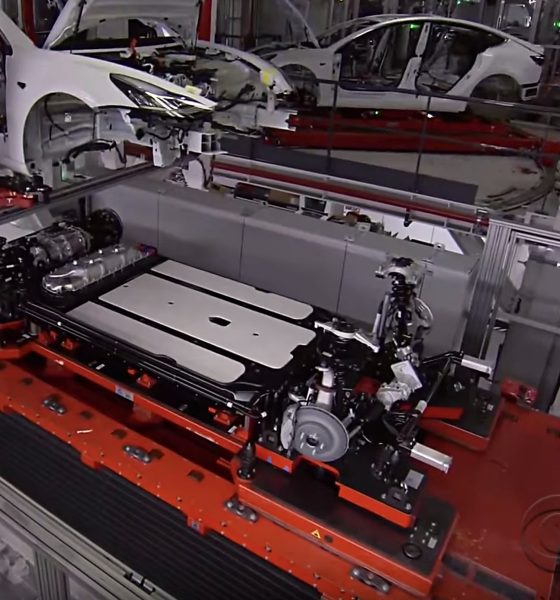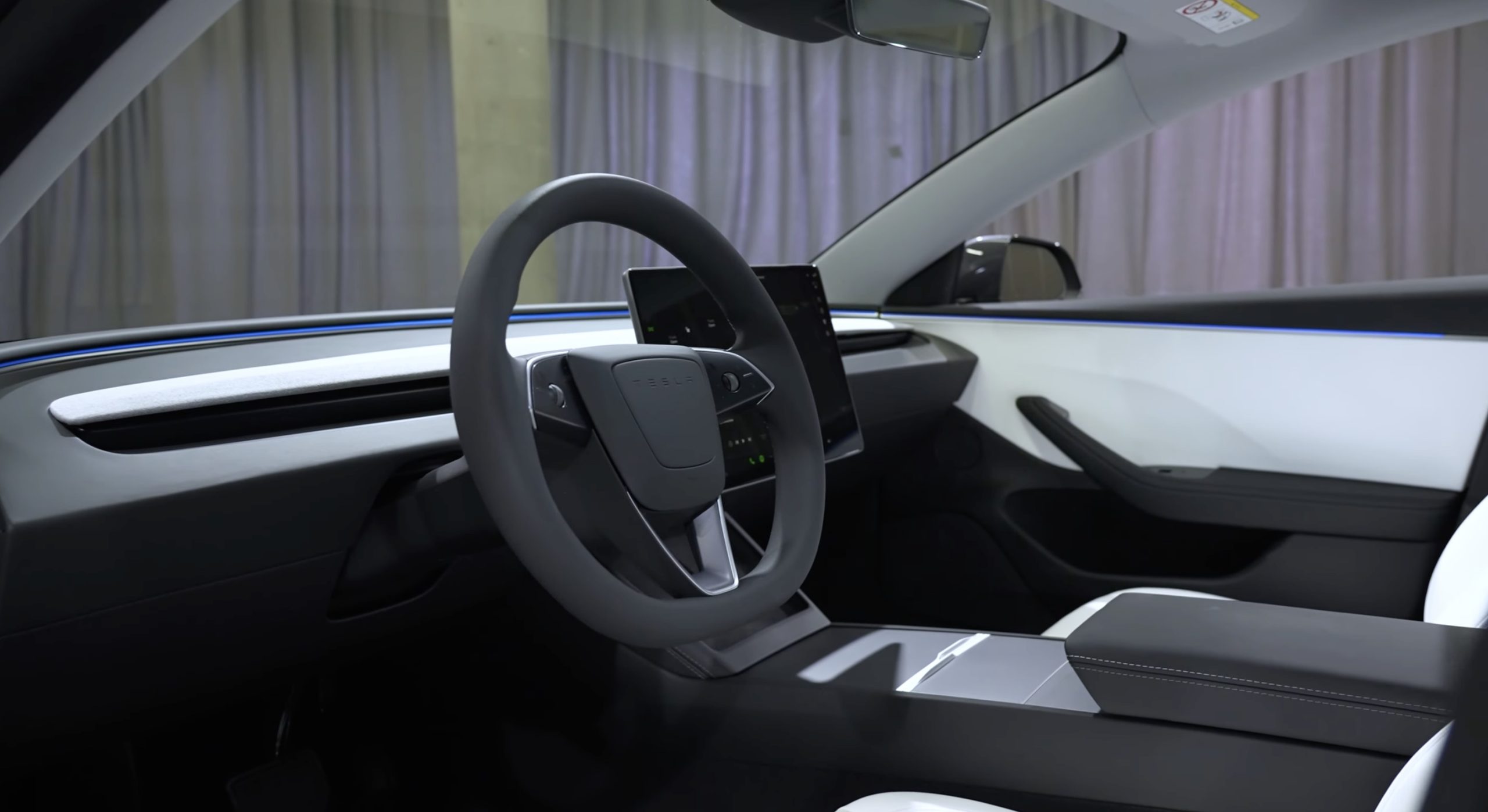

News
Tesla’s approach to battery technology keeps it ahead in the EV industry
Tesla’s dominance in the growing electric vehicle (EV) industry is largely attributed to its unique approach to its battery technology. The engineering behind the all-electric car maker’s cylindrical cells speaks for itself in terms of the performance and range achieved, but in a recent interview with a battery technology researcher, a few things detailed about Tesla’s batteries stood out in particular.
Ravindra Kempaiah is a Ph.D. scholar at the University of Illinois Chicago focusing on advanced battery materials for his thesis. In his interview with Tesla owner and host of All Things EV, Sean Mitchell, Kempaiah explained lithium-ion technology in EVs and the primary issues faced in their development. Overall, the biggest challenge is balancing the three main components in battery production: energy density, cost, and cycle life. Increasing one area will significantly impact the other, and the ideal equation is always being sought after. For example, if you increase energy density for higher range and lower cost, the cycle life takes a major hit. If you increase density and life cycle, the battery alone can cost as much as $100k, as described by Kempaiah.
“We always want more range. We always want higher cycle life. We want our batteries to last 15-20 years and the car to go 500 miles, but this is a problem every battery scientist has faced for the last 30 years,” Kempaiah commented in the interview.
Tesla deals with the same balancing act as other battery-electric car makers; however, there are key factors which seem to have kept the company ahead in the industry.

First, Tesla’s choice of cylindrical cells sets it apart from every other electric vehicle on the market. This provides several advantages that drive performance, flexibility, and cost control. Notably, Rivian is also using cylindrical cells, although their vehicles are not yet under production.
Out of the three types of cells available (cylindrical, prismatic, and pouch cells), cylindrical is the most cost-effective to produce. Namely, the cost per kWh is lower in cylindrical cells versus other types. The metallic jacket around the 18650 and 2170 cylindrical cells used in the Tesla Model S/X and Model 3, respectively, acts as scaffolding and provides structural rigidity to the battery. Additionally, in high powered situations, current draw and distribution of power is over the entirety of the battery pack instead of concentrated in a certain section, according to Kempaiah.
Second, Tesla uses a liquid-cooled thermal management system to manage battery temperatures whereas other automakers take a more economical air cooling approach. By adjusting the temperature of the battery pack, Tesla is able to ensure that cells are operating in their most efficient and optimal states, thereby maximizing battery longevity as well as performance. While reducing cost is an important factor in accelerating the growth of the electric vehicle market, Tesla’s investment in thermal management technology provides an upside for owners who may be looking for longevity and long-term affordability of their cars.

Third, Tesla has actively sought to limit the amount of cobalt it uses in its batteries and already uses less of the element than other companies in the Model 3 batteries. The scarcity of cobalt and its mining sources have subjected it to socioeconomic situations that are more than problematic in the United States, i.e., child labor and similar abuses are widespread in its sourcing. With this in mind, Tesla has been working on the question, “Is cobalt really needed?”
Cobalt is used as a cathode in battery technology, and out of all cathode materials available, it has the highest cost both fiscally and politically. Current consensus on battery technology says that without cobalt, the structural integrity and cycle life in batteries is compromised, as described in the interview. However, some recent scientific literature was cited by Kempaiah that indicated higher nickel content limited the impact of cobalt on batteries, possibly removing the need to use it at all. Nickel is more widely available across the globe, which keeps its cost down and mitigates the socioeconomic impacts often associated with resource mining operations. Overall, the discussion between Mitchell and Kempaiah indicated that Tesla can probably go cobalt-free soon, making it less vulnerable to the cobalt industry.
Finally, Tesla takes great care to educate its customers about proper battery maintenance, especially with regard to the negative impact of bad charging habits. Specifically, keeping an electric car battery charged at 100% for long periods degrades the battery very quickly, while keeping charging states within an optimal range will give it a long life. Tesla makes it a point to communicate to customers the importance of battery health on their overall ownership experience and value of their purchase.
When asked for his opinion by Mitchell, Kempaiah attributed the lack of education by other brands as a disconnect between engineering teams and marketing teams. While battery “best practices” are provided to EV customers by all manufacturers, the importance of communicating the true impact of bad charging habits may not be emphasized enough to be included as prominently as it should.
In summary, Tesla is constantly developing the technology in its vehicles, and its particular attention to its batteries looks to have given the company a significant advantage over its competitors. Perhaps other automakers will take a few tips from Tesla in the future, even if it’s as limited as improving communications with customers.
Watch Sean Mitchell’s full interview with Ravindra Kempaiah below:

Elon Musk
Tesla CEO Elon Musk announces major update with texting and driving on FSD
“Depending on context of surrounding traffic, yes,” Musk said in regards to FSD v14.2.1 allowing texting and driving.

Tesla CEO Elon Musk has announced a major update with texting and driving capabilities on Full Self-Driving v14.2.1, the company’s latest version of the FSD suite.
Tesla Full Self-Driving, even in its most mature and capable versions, is still a Level 2 autonomous driving suite, meaning it requires attention from the vehicle operator.
You cannot sleep, and you should not take attention away from driving; ultimately, you are still solely responsible for what happens with the car.
The vehicles utilize a cabin-facing camera to enable attention monitoring, and if you take your eyes off the road for too long, you will be admonished and advised to pay attention. After five strikes, FSD and Autopilot will be disabled.
However, Musk announced at the Annual Shareholder Meeting in early November that the company would look at the statistics, but it aimed to allow people to text and drive “within the next month or two.”
He said:
“I am confident that, within the next month or two, we’re gonna look at the safety statistics, but we will allow you to text and drive.”
“I am confident that, within the next month or two, we’re gonna look at the safety statistics, but we will allow you to text and drive.”
Does anyone think v14.3 will enable this? pic.twitter.com/N2yn0SK70M
— TESLARATI (@Teslarati) November 23, 2025
Today, Musk confirmed that the current version of Full Self-Driving, which is FSD v14.2.1, does allow for texting and driving “depending on context of surrounding traffic.”
Depending on context of surrounding traffic, yes
— Elon Musk (@elonmusk) December 4, 2025
There are some legitimate questions with this capability, especially as laws in all 50 U.S. states specifically prohibit texting and driving. It will be interesting to see the legality of it, because if a police officer sees you texting, they won’t know that you’re on Full Self-Driving, and you’ll likely be pulled over.
Some states prohibit drivers from even holding a phone when the car is in motion.
It is certainly a move toward unsupervised Full Self-Driving operation, but it is worth noting that Musk’s words state it will only allow the vehicle operator to do it depending on the context of surrounding traffic.
He did not outline any specific conditions that FSD would allow a driver to text and drive.
News
Tesla Semi just got a huge vote of confidence from 300-truck fleet
The confidential meeting marks a major step for the mid-sized carrier in evaluating the electric truck for its regional routes.

The Tesla Semi is moving closer to broader fleet adoption, with Keller Logistics Group wrapping up a key pre-production planning session with the electric vehicle maker’s team this week.
The confidential meeting marks a major step for the mid-sized carrier in evaluating the electric truck for its regional routes.
Keller’s pre-production Tesla Semi sessions
Keller Logistics Group, a family-owned carrier with over 300 tractors and 1,000 trailers operating in the Midwest and Southeast, completed the session to assess the Tesla Semi’s fit for its operations. The company’s routes typically span 500-600 miles per day, positioning it as an ideal tester for the Semi’s day cab configuration in standard logistics scenarios.
Details remain under mutual NDA, but the meeting reportedly focused on matching the truck to yard, shuttle and regional applications while scrutinizing economics like infrastructure, maintenance and incentives.
What Keller’s executives are saying
CEO Bryan Keller described the approach as methodical. “For us, staying ahead isn’t a headline, it’s a habit. From electrification and yard automation to digital visibility and warehouse technology, our teams are continually pressure-testing what’s next. The Tesla Semi discussion is one more way we evaluate new tools against our standards for safety, uptime, and customer ROI. We don’t chase trends, we pressure-test what works,” Keller said.
Benjamin Pierce, Chief Strategy Officer, echoed these sentiments. “Electrification and next-generation powertrains are part of a much broader transformation. Whether it’s proprietary yard systems like YardLink™, solar and renewable logistics solutions, or real-time vehicle intelligence, Keller’s approach stays the same, test it, prove it, and deploy it only when it strengthens service and total cost for our customers,” Pierce said.
News
Tesla extends FSD Supervised ride-alongs in Europe by three months
Needless to say, it does appear that FSD fever is starting to catch in Europe.

Tesla appears to be doubling down on its European Full Self-Driving (Supervised) push, with the company extending its demo ride-along program by three months until the end of March 2026. The update seems to have been implemented due to overwhelming demand.
Needless to say, it does appear that FSD fever is starting to catch in Europe.
Extended FSD demonstrations
Tesla EU Policy and Business Development Manager Ivan Komušanac shared on LinkedIn that the company is offering ride-along experiences in Germany, France and Italy while working toward FSD (Supervised) approval in Europe.
He noted that this provides a great feedback opportunity from the general public, encouraging participants to record and share their experiences. For those unable to book in December, Komušanac teased more slots as “Christmas presents.”
Tesla watcher Sawyer Merritt highlighted the extension on X, stating that dates now run from December 1, 2025, to March 31, 2026, in multiple cities including Stuttgart-Weinstadt, Frankfurt and Düsseldorf in Germany. This suggests that the FSD ride-along program in Europe has officially been extended until the end of the first quarter of 2026.
Building momentum for European approval
Replies to Merritt’s posts buzzed with excitement, with users like @AuzyMale noting that Cologne and Düsseldorf are already fully booked. This sentiment was echoed by numerous other Tesla enthusiasts on social media. Calls for the program’s expansion to other European territories have also started gaining steam, with some X users suggesting Switzerland and Finland as the next locations for FSD ride-alongs.
Ultimately, the Tesla EU Policy and Business Development Manager’s post aligns with the company’s broader FSD efforts in Europe. As per recent reports, Tesla recently demonstrated FSD’s capabilities for Rome officials. Reporters from media outlets in France and Germany have also published positive reviews of FSD’s capabilities on real-world roads.








